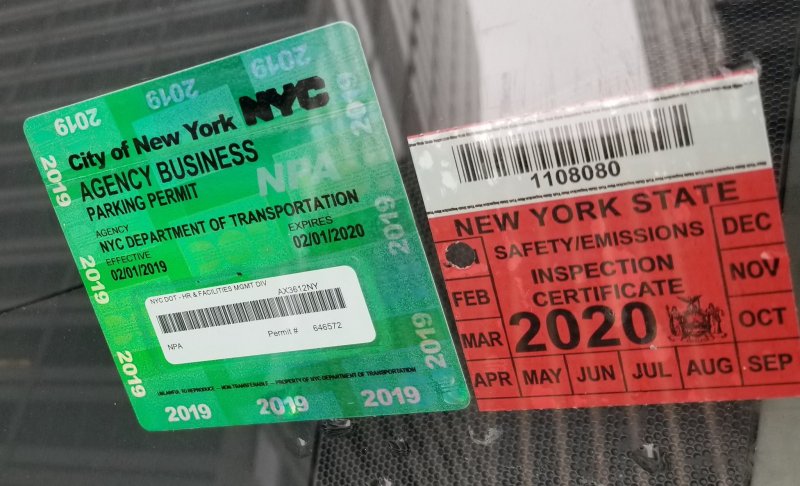Here’s Something New: Barcode-Adorned Placards in Lower Manhattan
Barcodes will make placards harder to forge — but it won't force NYPD traffic agents to ticket their fellow government employees who park illegally and dangerously.

There’s a new parking placard in town — and, judging by the looks of it, it’s going to be a lot harder to fake.
The @placardabuse Twitter account shared a photo on Thursday afternoon of a city Department of Transportation-owned sedan emblazoned with a fancy DOT-official barcode decal.
Across the city, public officials and imposters get away with illegal and unsafe parking in front of fire hydrants and crosswalks, in bike lanes and bus lanes — and even on sidewalks — thanks to parking placards, which are distributed in the hundreds of thousands. They get away with it, in large part, because NYPD traffic agents follow an unspoken courtesy to not ticket their fellow city employees (or their fellow NYPD employees).
“It’s called the brotherhood of city workers that look out for each other,” former Koch administration Traffic Commissioner Sam Schwartz told Streetsblog earlier this week.
Mayor de Blasio has promised an update on placard abuse this month, but from the looks of this new-fangled placard, which the administrators of the placard abuse account say is a novelty, perhaps this is it.
Of course, making placards harder to forge only scratches the surface of the problem. The DOT vehicle in question was parked illegally in a no-standing zone — a zone that had been created by DOT itself to ensure driver visibility of crossing pedestrians.
Unsurprisingly, the car wasn’t ticketed:
Too bad it was on a car parked illegally in a No Standing zone, blocking sight lines where @NYC_DOT posted the regulation to daylight the crosswalk.
But it wasn't ticketed because of #placardcorruption. pic.twitter.com/l2BJv3lKSR
— placard corruption (@placardabuse) February 8, 2019
The mayor’s forthcoming announcement will be the much-delayed follow-up to his mid-2017 promise to crack down on the problem. At the time, de Blasio’s solution was to launch a dedicated placard enforcement unit. But anyone who has walked near a government building in this city can tell you the impact of that enforcement hike has been negligible. The @placardabuse Twitter account repeatedly riffs on the city’s supposed crackdown — and the seemingly endless parade of examples that show it’s a farce.
The very existence of parking placards compounds the city’s congestion problems. On a whole, city employees are less likely to own cars than the average New Yorker, but because parking placards ensure them free on-street spots, they’re actually more likely to commute by car into Manhattan. Because of that, placard reform was one of the many congestion-tackling recommendations put out by the MTA Sustainability Advisory Workgroup in December [PDF].
As Schwartz sees it, there’s little reason for at least two-thirds of the placards currently in circulation.
“Easily 75 percent of the placards probably could go,” he said. “The only ones who should get placards are people who don’t use it for commutation.”
Politically, placard reform is an uphill battle because of the power civil servants have to shape narratives and wreak havoc on their elected and appointed superiors. In 2017, the de Blasio administration capitulated to demands from labor unions and dolled out 50,000 placards to the city’s public school teachers.
“Everybody in New York has that same problem — ‘How do I get to work?'” said Brooklyn-based parking expert Rachel Weinberger. “Public employees should also take the subway. They should also carpool. They should have to pay to park in a garage.”





